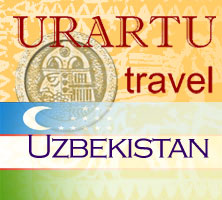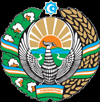About Uzbekistan
General Information -- Geography -- Climate -- Religion -- Language -- Population and Ethnic Composition-- Government -- Administrative Division -- Time Zone -- Currency Exchange and Credit Cards -- Capital City -- Official Holidays -- Airports and Public Transportation -- Traditional Cuisine -- Brief History
General Information
Uzbekistan, officially the Republic of Uzbekistan, is a doubly landlocked country in Central Asia. The name Uzbekistan is derived from Persian, meaning "land of the Uzbeks".
Geography
Uzbekistan is approximately the size of Spain or California and has an area of 447,400 square kilometers. Uzbekistan stretches 1,425 kilometers from west to east and 930 kilometers from north to south. Bordering Turkmenistan to the southwest, Kazakhstan and the Aral Sea to the north, and Tajikistan and Kyrgyzstan to the south and east, Uzbekistan is not only one of the larger Central Asian states but also the only Central Asian state to border all of the other four. Uzbekistan also shares a short border with Afghanistan to the south.
Uzbekistan is a dry, country of which 10% consists of intensely cultivated, irrigated river valleys. It is one of two double-landlocked countries in the world - the other being Liechtenstein, although in the case of Uzbekistan this is less clear, since it has borders with two countries (Kazakhstan in the north and Turkmenistan in the south) bordering the landlocked but non-freshwater Caspian Sea from which ships can reach the Sea of Azov and thus the Black Sea, the Mediterranean Sea and the oceans.
Climate
Mostly mid-latitude desert, long, hot summers, mild winters; semiarid grassland in east
Religion
Muslim 88% (mostly Sunnis), Eastern Orthodox 9%, other 3%
Language
Uzbek is an Eastern Turkic language and the official language of Uzbekistan. It has about 21.5 million native speakers, and it is spoken by the Uzbeks in Uzbekistan and elsewhere in Central Asia. Uzbek belongs to the Qarluq family of Turkic languages, and consequently its lexicon and grammar are most closely linked to the Uighur language, while other influences rose from Persian, Arabic and Russian. Other languages spoken in Uzbekistan are Russian 14.2%, Tajik 4.4%, other 7.1%
Population and Ethnic Composition
Uzbekistan is Central Asia's most populous country. Its 26 million people, concentrated in the south and east of the country, comprise nearly half the region's total population. In the recent years, the fraction of the rural population has continued to increase now reaching 63.5%. The population of Uzbekistan is very young: 34.1% of it are people younger than 14.
Uzbekistan is predominantly Uzbek in ethnic composition. According to the CIA World Factbook, Uzbeks comprise 80% of the total population. Other ethnic groups include Russian 5.5%, Tajik 5%, Kazakhs 3%, Karakalpak 2.5%, and Tatar 1.5%. However, some sources put the percentage of Tajik population of Uzbekistan at approximately 42%.
Government
The presidency was instituted in Uzbekistan on March 24, 1990. The president is the head of the state and executive power. The president of the Republic of Uzbekistan is simultaneously the Chairman of the Cabinet of Ministers of the Republic of Uzbekistan. The President is elected by nation-wide elections for a term of five years. The constitutional authorities of the President are extensive.
The Oliy Majlis is the supreme representative body in the republic. The law on the elections to the Oliy Majlis was issued on December 28, 1993.
The Government of the Republic of Uzbekistan is the executive power body of the Republic of Uzbekistan, ensuring guidance over effective functioning of the economy, social and cultural development, execution of the laws, and other decisions of Oliy Majlis, as well as decrees and resolutions issued by the President of the Republic of Uzbekistan.
Administrative Division
Uzbekistan is divided into 12 provinces (viloyatlar), 1 autonomous republic, and 1 independent city.
Time Zone
Uzbekistan - Time Standard Time is 5 hours ahead of Greenwich Mean Time (GMT+5).
Uzbekistan - Time does not operate Daylight-Saving Time.
Currency Exchange and Credit Cards
The som (UZS) is the currency of Uzbekistan. 1 Sum = 100; tiyn. Banknotes; are in denominations of Sum 1000, 500, 200, 100, 50, 25,10, 5, 3 and 1. Coins are in denominations of 50, 10, 5, 3 and 1 tiyn.
Credit & debit cards are accepted in some major hotels located in tourist centres.
Capital City
Tashkent ("Stone City" in English) is the current capital of Uzbekistan and also of Tashkent Province. The population of the city in 1999 was 2,142,700. Due to the destruction of most of the ancient city during 1917 revolution and, later, to the 1966 earthquake, little remains of Tashkent's traditional architectural heritage. Tashkent is, however, rich in museums and Soviet-era monuments.
Official Holidays
- January 1 - New Year
- March 8 - International Women's Day
- Mar 21 - Navruz
- May 9 - Day of Memory and Remembrance
- September 1 - Independence Day
- December 8 - Constitution Day
- Varies - Hait (Eid-Al-Fitr)
- Varies - Qurban-Hait (Eid-Al-Adha)
Airports and Public Transportation
Yuzhny Airport, also known as Tashkent Yuzhny Airport, is located in Tashkent, Uzbekistan. The largest airport in Uzbekistan, Yuzhny serves as the hub of Uzbekistan Airways and serves flights to and from dozens of capitals in the CIS, Middle East and Europe.
Traditional Cuisine
In every Uzbek house a guest is always offered a piala (a small bowl) of aromatic green tea, accompanied with fresh tandyr (clay oven)-baked flat Uzbek bread.
A traditional feast at an Uzbek home starts with sweets. Usually offered along tea, they feature crystallized sugar navat; the parvarda candy, which is made from flour and sugar; sweet tiny cakes; the halva halvoiytar. This is followed by the rich mutton soup shurpa, spiced up with plenty of fennel and parsley.
One of the favorite dishes in Uzbekistan is lagman. This dish, combining in itself the first and the second course, contains long handmade noodles dressed with sauce with pieces of meat and vegetables.
Yet the main dish of the Uzbek cuisine is pilav. Pilav is an indispensable part of any festive meal: none of the weddings or any other important occasions, on which guests are ever received, can do without it.
The respect of the Uzbeks for pilav can be traced in their language: the Uzbek for 'pilav' is 'osh', which literally means 'food'.
As a rule, pilav is served with green radish chopped into thin sticks, or with the salad achik-chuchuk which is made from finely cut tomatoes, onions and chilly.
Uzbek cuisine is not complete without the flaky pasty somsa, which has minced meat and a piece of fat of sheep's tail inside; or the original ravioli-like Uzbek manty, which are filled with meat, steamed potatoes or sweet pumpkin.
Traditionally any Uzbek feast is crowned with mutton or beef kebab, the most delicious of which is the jigar-kebab, made of sheep's liver.
Brief History
The territory of Uzbekistan was populated in the second millennium BC. There are findings of early human tools and monuments in Ferghana, Tashkent, Bukhara, Khorezm, Samarkand regions.
The first civilizations to appear in Uzbekistan were Sogdiana, Bactria and Khwarezm. Territories of these states became a part of the Persian Achaemenid empire in the 6th century, hence becoming part of Persia for centuries. In fact, the Persian culture is preserved in Uzbekistan even today, as is evident in many areas where Persian is spoken.
Alexander the Great conquered Sogdiana and Bactria in 327 BC, marrying Roxana, daughter of a local Sogdian chieftain. However, the conquest was supposedly of little help to Alexander as popular resistance was fierce, causing Alexander's army to be bogged down in the region.
Its territory was overrun by Genghis Khan and his Mongol tribes in 1220.
In the 1300s, Timur, known in the west as Tamerlane, overpowered the Mongols and built an empire. In his military campaigns Tamerlane reached as far as the Middle East. He defeated Ottoman Emperor Bayezid I and rescued Europe from Turkish conquest. Tamerlane sought to build a capital of his empire in Samarkand. The imagery of Tamerlane would be used later in history to construct an Uzbek national identity.
In the 19th century, the Russian Empire began to expand, and spread into Central Asia. The "Great Game" period is generally regarded as running from approximately 1813 to the Anglo-Russian Convention of 1907. Following the Bolshevik Revolution of 1917 a second less intensive phase followed. At the start of the 19th century there were some 3,200km separating British India and the outlying regions of the Tsarist Russia. Much of the land in between was unmapped.
By the beginning of the 20th century, Central Asia was firmly in the hands of Russia and despite some early resistance to Bolsheviks, Uzbekistan and the rest of Central Asia became a part of the Soviet Union. On August 31, 1991, Uzbekistan reluctantly declared independence, marking September 1 as a national holiday.
The country now seeks to gradually lessen its dependence on agriculture - it is the world's second-largest exporter of cotton - while developing its mineral and petroleum reserves.



